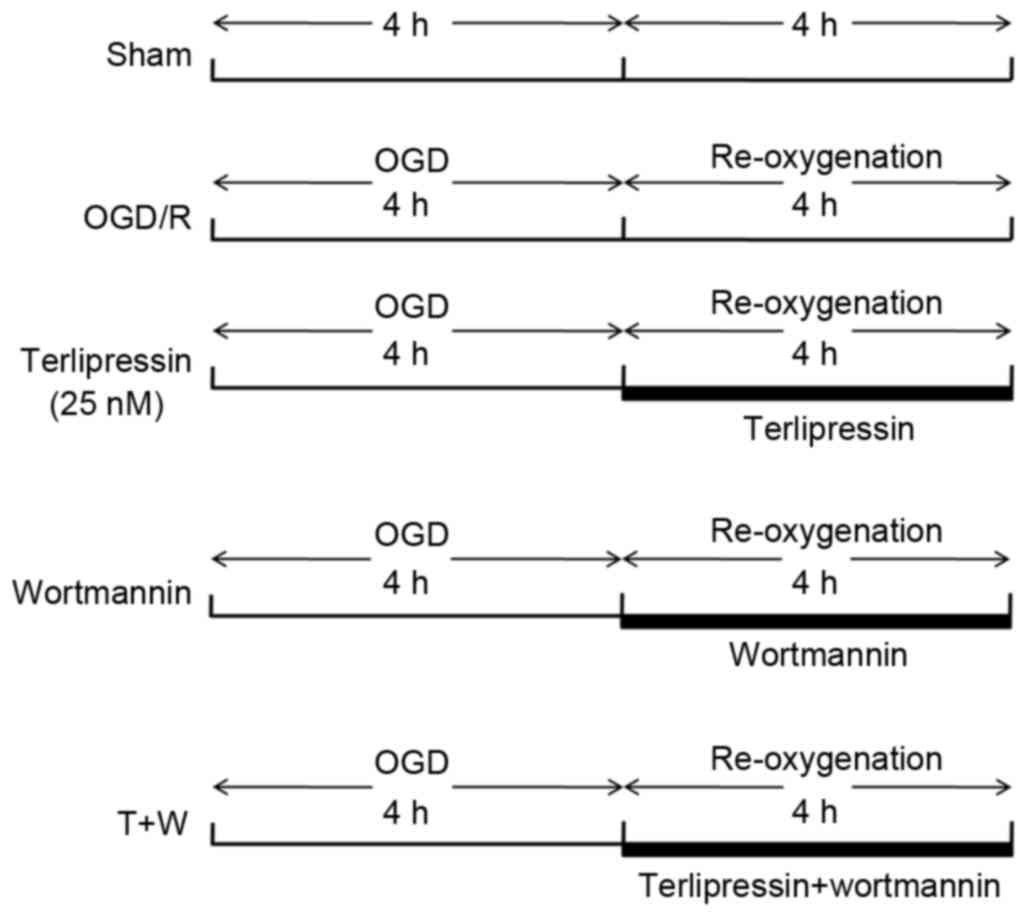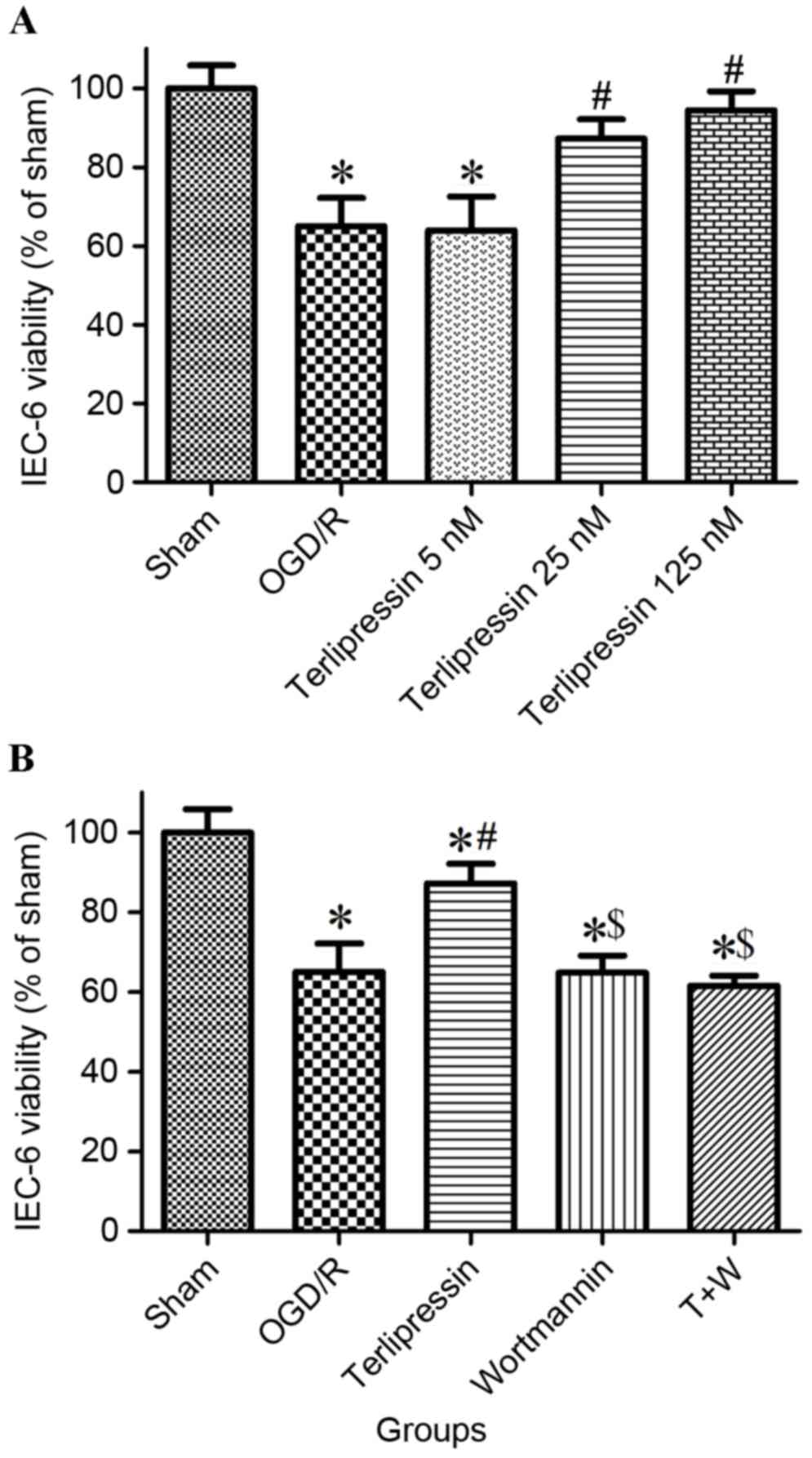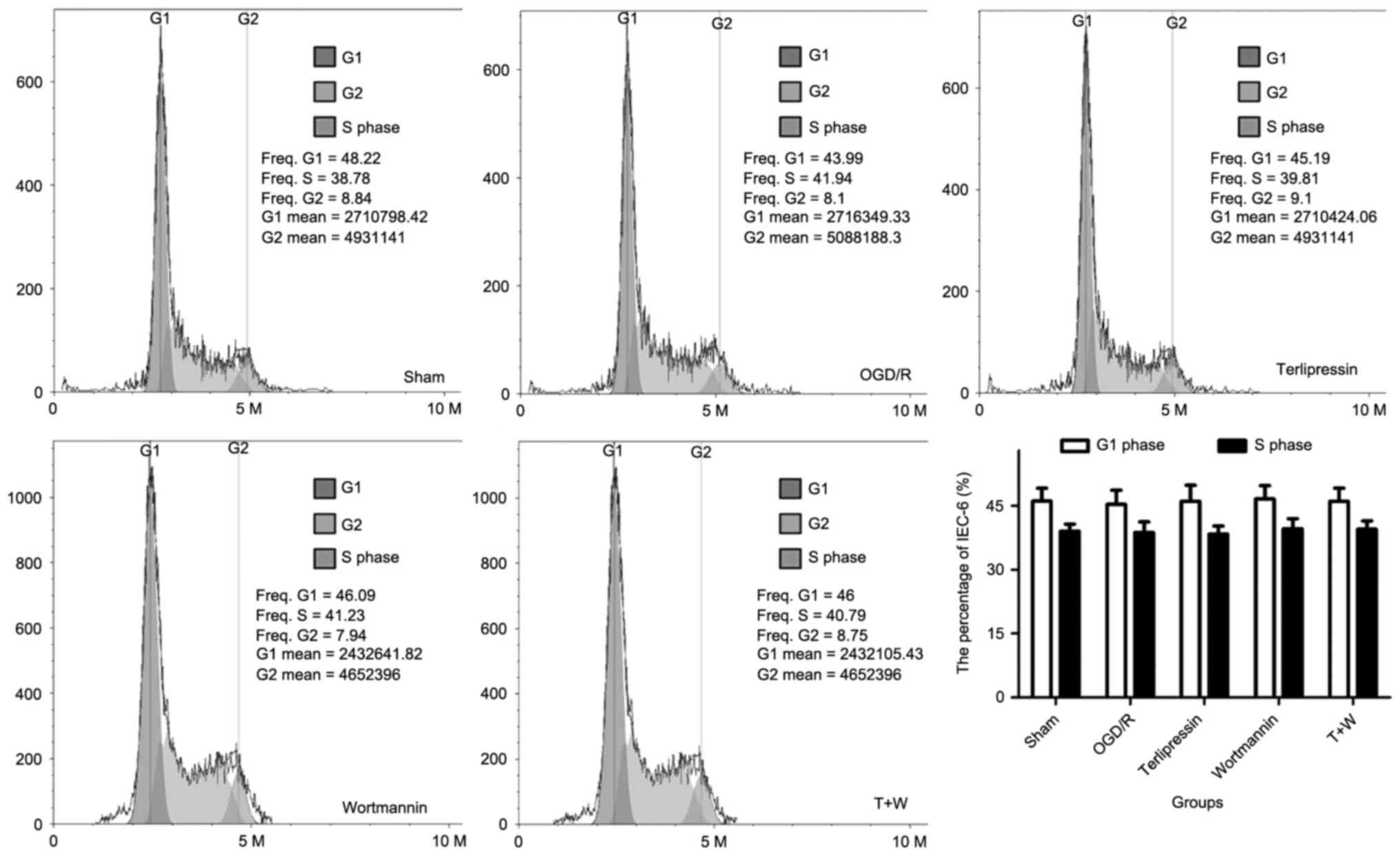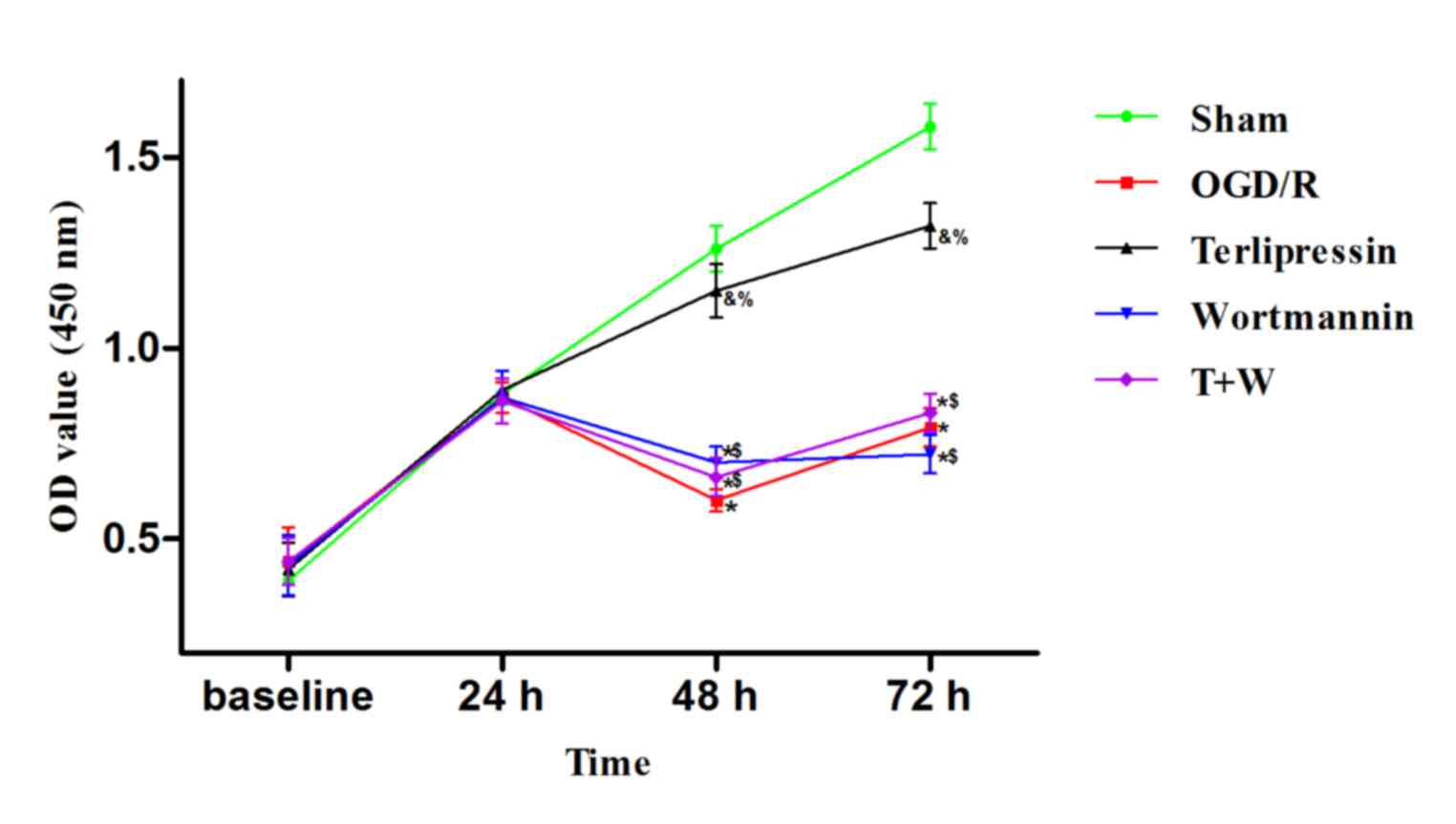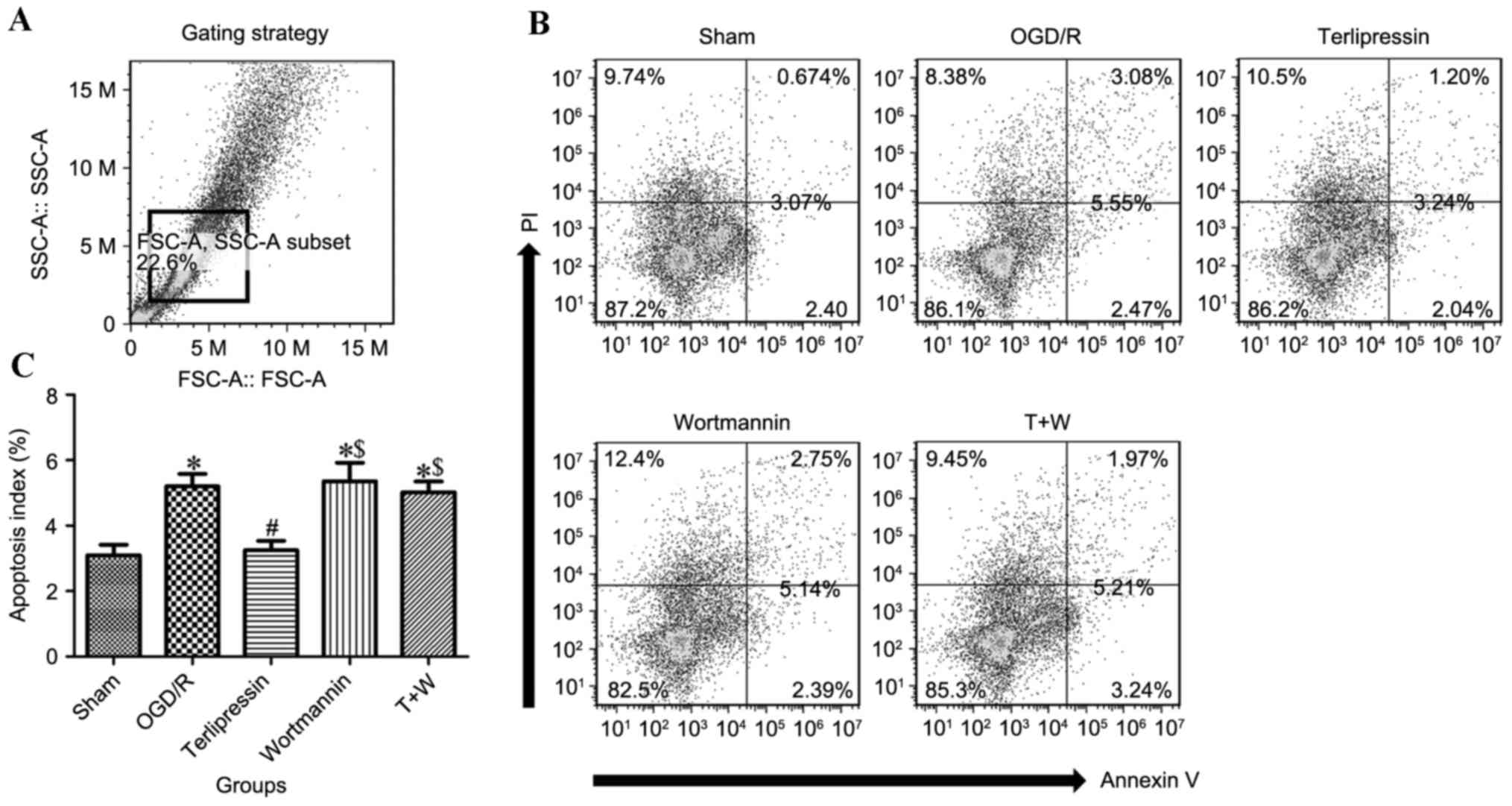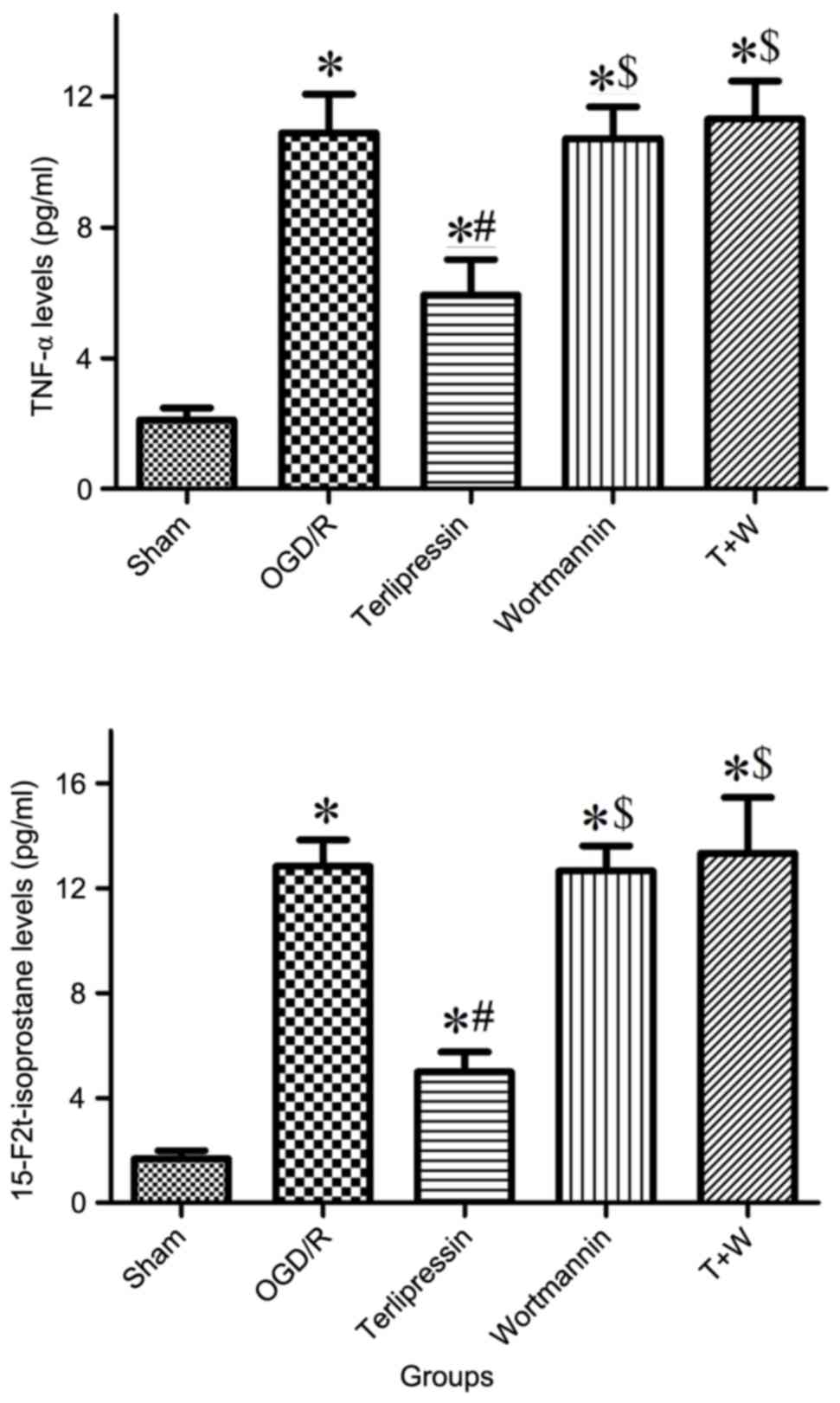Terlipressin protects intestinal epithelial cells against oxygen-glucose deprivation/re-oxygenation injury via the phosphatidylinositol 3-kinase pathway
- Authors:
- Published online on: May 23, 2017 https://doi.org/10.3892/etm.2017.4502
- Pages: 260-266
-
Copyright: © Liu et al. This is an open access article distributed under the terms of Creative Commons Attribution License.
Abstract
Introduction
Intestinal ischemia/reperfusion (I/R) injury usually occurs following acute mesenteric ischemia, severe trauma or burns, hemorrhagic or septic shock, and major surgical procedures (1). Intestinal I/R causes excessive inflammation, oxidative response and cell apoptosis, and subsequently leads to the disruption of the intestinal barrier and distant organ damage (1). The development of intestinal I/R is associated with multiple organ dysfunction syndrome and a high probability of mortality (2,3). Indeed, a recent multicenter study determined that the mortality rate from acute mesenteric ischemia in intensive care units (ICU) was as high as 58% (4). In clinical settings, vasopressors including norepinephrine and dobutamine are essential to maintain blood pressure and systemic perfusion in critically ill patients with intestinal I/R injury.
Vasopressin is generally used for cardiovascular support in the ICU (5) and is recommended for the treatment of severe sepsis and septic shock (6). However, it remains unclear whether vasopressin aggravates intestinal I/R injury. Previous studies have suggested that vasopressin decreases intestinal mucosal perfusion and diminishes the beneficial effect of norepinephrine due to its potent vasoconstriction (7–9). This suggests that the use of vasopressin may further deteriorate intestinal mucosal ischemia in critically ill patients with intestinal I/R. However, other studies have indicated that vasopressin does not compromise gut mucosal microcirculation and oxygen supply (10,11). To the best of our knowledge, there have been no studies investigating the effects of vasopressin on intestinal mucosal epithelial cells, the key component of the intestinal barrier, under I/R conditions. Thus, it is of clinical relevance to clarify the effect of vasopressin and its analogue on intestinal epithelial tissues in patients at risk of intestinal ischemia.
Performing oxygen and glucose deprivation and re-oxygenation (OGD/R) in vitro is a popular method to simulate organic I/R in vivo. Therefore, the present study was designed to assess the effects of terlipressin, a highly selective vasopressin V1 receptor agonist, on the production of inflammatory and oxidative cytokines in rat intestinal epithelial cells (IEC-6), and on cell viability and proliferation in the OGD/R model.
Materials and methods
IEC-6 cell culture
Rat IEC-6 intestinal epithelial cells (CRL-1592; passage 16–20; American Type Culture Collection, Manassas, VA, USA) were cultured as previously described (12). Briefly, IEC-6 cells were cultured in Dulbecco's modified Eagle's medium (DMEM) containing 4.5 g/l D-glucose, 10% v/v fetal bovine serum (all from Sigma-Aldrich; Merck KGaA, Darmstadt, Germany) and 1% penicillin/streptomycin (Invitrogen; Thermo Fisher Scientific, Inc., Waltham, MA, USA) and maintained under standard cell culture conditions of 37°C, 5% CO2 and 21% O2 for 24 h.
OGD/R
OGD intervention was conducted as previously described (12). Briefly, after the IEC-6 cells were grown under normal conditions up to 80% confluence, the DMEM was replenished with D-Hanks buffer (Sigma-Aldrich; Merck KGaA) and cells were incubated in a modular incubator chamber filled with a 95% N2 and 5% CO2 gas mixture for 4 h at 37°C. Following completion of OGD, medium was changed back to normoxic medium and the cells were incubated under normal conditions for 4 h (re-oxygenation).
Study groups and experimental protocol
IEC-6 cells were randomly assigned to receive different concentrations (1, 5, 25 or 125 nM) terlipressin (Hybio Pharmaceutical Co., Ltd., Shenzhen, China) following OGD, and then an appropriate concentration of terlipressin (25 nM) was selected according to the results of the cell viability test. Subsequently, cells were incubated with the chosen concentration of terlipressin and/or phosphatidylinositol 3-kinase (PI3K) inhibitor (Wortmannin; Beyotime Institute of Biotechnology, Haimen, China). Cells were randomly assigned to one of 5 groups (5 samples per group) as follows: i) Sham group: IEC-6 cells were incubated in normoxic medium for 8 h; ii) OGD/R group: IEC-6 cells were incubated for 4 h OGD followed by 4 h re-oxygenation; iii) terlipressin group: Following 4 h OGD, IEC-6 cells were incubated with 25 nM terlipressin for 4 h; iv) wortmannin group: Following 4 h OGD, IEC-6 cells were incubated with 2 µM wortmannin, a specific PI3K inhibitor, for 4 h; or v) T+W group: 2 µM wortmannin and 25 nM terlipressin were simultaneously administrated at the beginning of re-oxygenation. The detailed experimental protocol is presented in Fig. 1.
Cell viability assay
IEC-6 cells were seeded into 96-well plates (1×105 cells/well) and incubated overnight at 37°C in 5% CO2. Cells were then treated according to the aforementioned experimental protocol, with a sham cell group as a control. An MTT assay was used to determine cell viability as previously described (12). Briefly, MTT (3-(4,5-dimethylthiazol-2-yl)-2,5-diphenyl tetrazoliumbromide; 5 mg/ml in phosphate-buffered saline) reagent (Sigma-Aldrich; Merck KGaA) was added to each well and incubated for 4 h at 37°C. Medium was then replaced with 150 µl dimethyl sulfoxide. Optical density (OD) was recorded using a microplate reader at the wavelength of 490 nm. Cell viability was expressed as a percentage of the Sham.
Cell cycle analysis
Cell cycle distribution was measured by a flow cytometry assay with propidium iodide (PI) DNA staining. Briefly, IEC-6 cells were seeded into 96-well plates (1×105 cells/well) and treated according to the aforementioned experimental protocol, with a sham cell group as a control. Cells were harvested and digested with 0.25% trypsin solution without EDTA (Sigma-Aldrich; Merck KGaA) for 15 min at 37°C, then isolated by centrifugation at 200 × g for 2 min at 4°C and washed twice with cold phosphate-buffered saline (PBS). Following 100 µm mesh sieve screening; the cell suspension was fixed with 75% ethanol at 4°C for 24 h. Cells were harvested by centrifugation at 200 × g for 10 min at 4°C and two washes in cold PBS, followed by centrifugation at 200 × g for 5 min at 4°C and cell collection by discarding of the supernatant. The cell suspension was then treated with 100 µl RNase (0.01 mol/l, Sigma-Aldrich; Merck KGaA) at 37°C for 30 min in a water bath, followed by treatment with PI staining solution (0.5 mg/l; Beyotime Institute of Biotechnology). Following 30 min of gentle mixing, cells were stored at 4°C in the dark for 30 min, then analyzed with a FACSCalibur™ Cell Analyzer (BD Biosciences, CA, USA). Red fluorescence at 488 nm was recorded using a microplate reader (Thermo Fisher Scientific, Inc.) and results were analyzed using Flowjo 7.6.3 software (Tree Star, Inc., OR, USA).
Cell proliferation assay
IEC-6 cell proliferation was measured using a cell counting kit-8 (CCK-8, Beyotime Institute of Biotechnology). At baseline (the start of experiment), and 24, 48 and 72 h after baseline, 5×103 cells/well were propagated in a 5% CO2 atmosphere at 37°C. Then, CCK-8 reagent was applied to the DMEM, incubated for 1 h and absorbance at 450 nm was measured using a multiwell spectrophotometer.
Apoptosis assay
IEC-6 cell apoptosis was measured by flow cytometry, following a previously described procedure (12). Cells were washed twice with cold PBS and stained with fluorescein isothiocyanate (FITC) Annexin V and PI using the Annexin V-FITC Apoptosis Detection kit I (BD Biosciences) for 15 min at room temperature in the dark. Stained cells were analyzed using flow cytometry within 1 h. The Annexin V+/PI− and Annexin V+/PI+ cell populations were considered to represent apoptotic cells. The apoptosis index was calculated as: (Apoptotic cells/total cells) ×100.
Tumor necrosis factor (TNF)-α and isoprostant assay
Following re-oxygenation, the culture medium was centrifuged at 600 × g for 5 min at 4°C, and the supernatant was collected. 15-F2t-isoprostane is a representative index of oxidative stress-induced lipid peroxidation (13). The concentrations of TNF-α and 15-F2t-isoprostane in the supernatant were determined using commercial kits (TNF-α: RTA00; R&D System, Inc., MN, USA and 15-F2t-isoprostane: 500431; Cayman Chemical Company, MI, USA), according to the manufacturer's procedure, as described previously (14,15).
Statistical analysis
Results were analyzed using SPSS 15.0 software (SPSS Inc, Chicago, IL, USA). Data were expressed as mean ± standard deviation. Data concerning cell proliferation were analyzed by two-way analysis of variance (ANOVA) with repeated measures. Other data were analyzed by one-way ANOVA with Tukey's post-test. P<0.05 was considered to indicate a statistically significant difference.
Results
Effect of terlipressin on IEC-6 cell viability following OGD/R
As presented in Fig. 2A, cell viability significantly decreased in the OGD/R group (P<0.01 vs. Sham). Incubation with 25 nM and 125 nM terlipressin increased cell viability (both P<0.01 vs. OGD/R), and cell viability in 125 nM group was similar to that in 25 nM group (P=0.756). Therefore, 25 nM terlipressin was selected to use in subsequent experiments. As depicted in Fig. 2B, cell viability significantly decreased in the OGD/R, Wortmannin and T+W groups (all P<0.01 vs. Sham). In addition, cell viability in the terlipressin group was significantly higher than that in the OGD/R, Wortmannin and T+W groups (all P<0.01), and was significantly lower than that in the Sham group (P<0.01).
Effect of terlipressin on IEC-6 cell cycle dynamics following OGD/R
As shown in Fig. 3, OGD/R intervention did not significantly alter cell cycle dynamics 4 h after re-oxygenation (all P>0.05 vs. Sham). Furthermore, terlipressin did not significantly influence the percentage of IEC-6 cells in G1 phase and in S-phase (all P>0.05 vs. OGD/R). Wortmannin and T+W did not significantly alter the percentage of IEC-6 cells in different phases of the cell cycle (P>0.05; Fig. 3).
Effect of terlipressin on IEC-6 cell proliferation following OGD/R
As indicated in Fig. 4, 24 h following the beginning of experiment (baseline), the OD value in the OGD/R group was similar to that in the Sham group (P=0.997). OD values at 48 and 72 h were significantly lower in the OGD/R group compared with the control (both P<0.01 vs. Sham). However, incubation with 25 nM terlipressin significantly increased the OD values at 48 and 72 h (P=0.034 and P=0.035 vs. OGD/R, respectively).
Effect of terlipressin on IEC-6 cell apoptosis following OGD/R
Apoptosis in IEC-6 cells was measured following OGD/R (Fig. 5). The flow cytometry gating strategy is depicted in Fig. 5A and representative histograms of each group are presented in Fig. 5B. The apoptosis index in the OGD/R group was significantly higher than that in the Sham group (P<0.01; Fig. 5C). However, terlipressin attenuated OGD/R-induced cell apoptosis (P<0.01 vs. OGD/R; Fig. 5C).
Effect of terlipressin on the production of TNF-α and isoprostane following OGD/R
TNF-α and 15-F2t-isoprostane levels increased following OGD/R (both P<0.01 vs. Sham; Fig. 6). Furthermore, terlipressin significantly inhibited the production of TNF-α and 15-F2t-isoprostane from IEC-6 cells (both P<0.01 vs. OGD/R; Fig. 6).
Effect of wortmannin on terlipressin-induced cell protection following OGD/R
Wortmannin alone (Wortmannin group) produced no significant impacts on the aforementioned variables compared with the OGD/R group (all P>0.05; Figs. 2–6). In the T+W group, wortmannin completely attenuated the effects of terlipressin on cell viability, proliferation and apoptosis (Figs. 2B, 4 and 5C). Moreover, the increased secretion of TNF-α and 15-F2t-isoprostane induced by terlipressin was also abolished by wortmannin (Fig. 6).
Discussion
In clinical settings, intestinal I/R injury is a serious condition and usually occurs prior to treatment with vasopressors. Therefore, in the present study, terlipressin was administrated following OGD to assess its effects on intestinal epithelial cells. The results of the current study demonstrated that terlipressin decreased the production of TNF-α and isoprostane in IEC-6 cells and improved cellular viability and proliferation, and decreased rates of apoptosis during OGD/R. Furthermore, the aforementioned protective effects of terlipressin were abolished by the specific PI3K inhibitor wortmannin.
Previous studies have indicated that vasopressin reduces neuronal death and apoptosis via the vasopressin V1a receptor (16,17). Similarly, Higashiyama et al (18) determined that arginine vasopressin inhibits the serum deprivation-induced apoptosis of glomerular mesangial cells by activating the V1a receptor. It has been demonstrated that in animals, apoptosis is the predominant mechanism of mucosal epithelial cell death during destruction of the intestinal epithelial barrier induced by intestinal I/R injury (19). Furthermore, a recent study performed by the current authors indicated that OGD/R significantly enhanced IEC-6 apoptosis in vitro and that remifentanil, a commonly used analgesic in general anesthesia, inhibited cell apoptosis and improved cell viability (12). To date however, no studies have investigated the effects of vasopressin on epithelial cell damage conferred by OGD/R. To the best of our knowledge, the current study is the first to demonstrate that terlipressin, an analogue of vasopressin, not only promoted IEC-6 viability but also decreased cellular apoptosis during OGD/R (Figs. 2 and 5), indicating that terlipressin management in vivo may provide direct protection for intestinal epithelial cells against I/R injury. Interestingly, incubation with terlipressin did not affect cell cycle and cell proliferation in the early period (<48 h) following re-oxygenation (Fig. 3) but significantly increased IEC-6 proliferation 48 and 72 h following OGD (Fig. 4). This delayed increase of cell proliferation induced by terlipressin may promote intestinal epithelial repair following intestinal I/R injury.
A previous study by the current authors indicated that overactivation of inflammatory response and oxidative stress was involved in the pathogenesis of intestinal I/R injury (15). Uncontrolled production of reactive oxygen species and inflammatory cytokines, including TNF-α and interleukin 1, is closely associated with the disruption of intestinal epithelia (20–21). A number of studies have determined that OGD/R increases the release of inflammatory cytokines or oxidative molecules in neural, renal tubular and vascular endothelial cells (22–25). The results of the present study demonstrated that OGD/R increased secretion of TNF-α and isoprostane from intestinal epithelial cells (Fig. 6). Ferrier et al (26) suggested that vasopressin increased TNF-α and myeloperoxidase levels through the V1b receptor in gut inflammatory disease. However, in septic animals, several studies have demonstrated that vasopressin may attenuate tissue inflammation and oxidative stress by activating the V1a receptor (27–29). Data from the current study indicate that terlipressin exerts anti-inflammatory and anti-oxidative effects during OGD/R attack (Fig. 6), suggesting that terlipressin may principally act on the V1a receptor of IEC-6 cells. Further investigations are required to determine the definite impacts of terlipressin, in vivo, on intestinal inflammation and oxidation during intestinal I/R insult.
Previous studies have indicated that vasopressin V1 receptor agonists deliver their effects through the PI3K signaling pathway (16,30). V1 receptors couple to Gq protein and Gq subsequently activates phospholipase C and PI3K (31). Notably, the PI3K pathway is involved in inflammation, oxidation and cell apoptosis under ischemic conditions (32–34). Therefore, a PI3K specific inhibitor, wortmannin, was used to explore the potential signaling pathway of terlipressin in this study. The results indicated that the protective effects of terlipressin were completely abolished by wortmannin (Figs. 2B and 4–6), indicating that terlipressin reduced OGD-induced IEC-6 cell damage via the PI3K pathway in vitro.
The current study had several limitations. Firstly, the effects of terlipressin on IEC-6 cells were investigated using an in vitro OGD/R model. Further analyses should be conducted to clarify the effects and mechanisms of telipressin on intestinal I/R injury in animals and in patients. Secondly, although terlipressin has a high binding affinity to V1 receptor agonist, a specific V1 receptor antagonist should be applied to verify that IEC-6 cell protection is mediated by V1 receptors. Finally, the downstream molecules of PI3K pathway were not measured in this study. An exact signal pathway may clearly interpret the protective effect of terlipressin following OGD injury.
In conclusion, the results of the current study demonstrate that, in vitro, OGD/R attack increases the production of TNF-α and isoprostane, as well as the apoptosis of IEC-6 cells, and decreases cell viability and proliferation. Moreover, the current results indicate for the first time that terlipressin reduces inflammation, oxidative stress and apoptosis, and directly protects IEC-6 cells against OGD/R-induced damage via the PI3K pathway. These important findings may help medical researchers and clinicians to better understand the pharmacological characteristics of terlipressin, and provide useful information for clinical trials and applications relevant to vasopressin.
Acknowledgements
The authors wish to express their gratitude to Ke-Xuan Liu (Department of Anesthesiology, The First Affiliated Hospital, Sun Yat-sen University) for the technical support given. The present study was supported by grants from the Natural Science Foundation of Guangdong Province, China (grant nos. 2014A030313210 and S2013010015398), and by a grant from the Major Science and Technology Projects of Guangdong province, China (grant no. 2012A080204018).
References
|
Mallick IH, Yang W, Winslet MC and Seifalian AM: Ischemia-reperfusion injury of the intestine and protective strategies against injury. Dig Dis Sci. 49:1359–1377. 2004. View Article : Google Scholar : PubMed/NCBI | |
|
Feinman R, Deitch EA, Watkins AC, Abungu B, Colorado I, Kannan KB, Sheth SU, Caputo FJ, Lu Q, Ramanathan M, et al: HIF-1 mediates pathogenic inflammatory responses to intestinal ischemia-reperfusion injury. Am J Physiol Gastrointest Liver Physiol. 299:G833–G843. 2010. View Article : Google Scholar : PubMed/NCBI | |
|
Martin B: Prevention of gastrointestinal complications in the critically ill patient. AACN Adv Crit Care. 18:158–166. 2007. View Article : Google Scholar : PubMed/NCBI | |
|
Leone M, Bechis C, Baumstarck K, Ouattara A, Collange O, Augustin P, Annane D, Arbelot C, Asehnoune K, Baldési O, et al: Outcome of acute mesenteric ischemia in the intensive care unit: A retrospective, multicenter study of 780 cases. Intensive Care Med. 41:667–676. 2015. View Article : Google Scholar : PubMed/NCBI | |
|
Holmes CL and Walley KR: Vasoactive drugs for vasodilatory shock in ICU. Curr Opin Crit Care. 15:398–402. 2009. View Article : Google Scholar : PubMed/NCBI | |
|
Dellinger RP, Levy MM, Rhodes A, Annane D, Gerlach H, Opal SM, Sevransky JE, Sprung CL, Douglas IS, Jaeschke R, et al: Surviving sepsis campaign: International guidelines for management of severe sepsis and septic shock: 2012. Crit Care Med. 41:580–637. 2013. View Article : Google Scholar : PubMed/NCBI | |
|
Knotzer H, Pajk W, Maier S, Ladurner R, Kleinsasser A, Wenzel V, Dünser MW, Ulmer H and Hasibeder WR: Arginine vasopressin reduces intestinal oxygen supply and mucosal tissue oxygen tension. Am J Physiol Heart Circ Physiol. 289:H168–H173. 2005. View Article : Google Scholar : PubMed/NCBI | |
|
Maier S, Hasibeder W, Pajk W, Hengl C, Ulmer H, Hausdorfer H, Wurzinger B and Knotzer H: Arginine-vasopressin attenuates beneficial norepinephrine effect on jejunal mucosal tissue oxygenation during endotoxinaemia. Br J Anaesth. 103:691–700. 2009. View Article : Google Scholar : PubMed/NCBI | |
|
Nygren A, Thorén A and Ricksten SE: Vasopressin decreases intestinal mucosal perfusion: A clinical study on cardiac surgery patients in vasodilatory shock. Acta Anaesthesiol Scand. 53:581–588. 2009. View Article : Google Scholar : PubMed/NCBI | |
|
Qiu X, Huang Y, Xu J, Qiu H and Yang Y: Effects of terlipressin on microcirculation of small bowel mesentery in rats with endotoxic shock. J Surg Res. 188:503–509. 2014. View Article : Google Scholar : PubMed/NCBI | |
|
Wafa K, Lehmann C, Wagner L, Drzymulski I, Wegner A and Pavlovic D: Desmopressin improves intestinal functional capillary density and decreases leukocyte activation in experimental endotoxemia. Microvasc Res. 97:98–104. 2015. View Article : Google Scholar : PubMed/NCBI | |
|
Shen JT, Li YS, Xia ZQ, Wen SH, Yao X, Yang WJ, Li C and Liu KX: Remifentanil preconditioning protects the small intestine against ischemia/reperfusion injury via intestinal δ- and μ-opioid receptors. Surgery. 159:548–559. 2016. View Article : Google Scholar : PubMed/NCBI | |
|
Milatovic D, Montine TJ and Aschner M: Measurement of isoprostanes as markers of oxidative stress. Methods Mol Biol. 758:195–204. 2011. View Article : Google Scholar : PubMed/NCBI | |
|
Wen SH, Li Y, Li C, Xia ZQ, Liu WF, Zhang XY, Lei WL, Huang WQ and Liu KX: Ischemic postconditioning during reperfusion attenuates intestinal injury and mucosal cell apoptosis by inhibiting JAK/STAT signaling activation. Shock. 38:411–419. 2012. View Article : Google Scholar : PubMed/NCBI | |
|
Zhang XY, Liu ZM, Wen SH, Li YS, Li Y, Yao X, Huang WQ and Liu KX: Dexmedetomidine administration before, but not after, ischemia attenuates intestinal injury induced by intestinal ischemia-reperfusion in rats. Anesthesiology. 116:1035–1046. 2012. View Article : Google Scholar : PubMed/NCBI | |
|
Chen J, Liu Y, Soh JW and Aguilera G: Antiapoptotic effects of vasopressin in the neuronal cell line H32 involve protein kinase Calpha and beta. J Neurocheml. 10:1310–1320. 2009. View Article : Google Scholar | |
|
Chen J, Volpi S and Aguilera G: Anti-apoptotic actions of vasopressin in H32 neurons involve MAP kinase transactivation and Bad phosphorylation. Exp Neurol. 211:529–538. 2008. View Article : Google Scholar : PubMed/NCBI | |
|
Higashiyama M, Ishikawa S and Saito T, Nakamura T, Kusaka I, Nagasaka S, Honda K and Saito T: Arginine vasopressin inhibits apoptosis of rat glomerular mesangial cells via V1a receptors. Life Sci. 68:1485–1493. 2001. View Article : Google Scholar : PubMed/NCBI | |
|
Ikeda H, Suzuki Y, Suzuki M, Koike M, Tamura J, Tong J, Nomura M and Itoh G: Apoptosis is a major mode of cell death caused by ischaemia and ischaemia/reperfusion injury to the rat intestinal epithelium. Gut. 42:530–537. 1998. View Article : Google Scholar : PubMed/NCBI | |
|
Wang G, Chen Z, Zhang F, Jing H, Xu W, Ning S, Li Z, Liu K, Yao J and Tian X: Blockade of PKCβ protects against remote organ injury induced by intestinal ischemia and reperfusion via a p66shc-mediated mitochondrial apoptotic pathway. Apoptosis. 19:1342–1353. 2014. View Article : Google Scholar : PubMed/NCBI | |
|
Ozacmak HS, Ozacmak VH, Barut F, Araslı M and Ucan BH: Pretreatment with mineralocorticoid receptor blocker reduces intestinal injury induced by ischemia and reperfusion: Involvement of inhibition of inflammatory response, oxidative stress, nuclear factor κB, and inducible nitric oxide synthase. J Surg Res. 191:350–361. 2014. View Article : Google Scholar : PubMed/NCBI | |
|
Wang WM, Liu Z, Liu AJ, Wang YX, Wang HG, An D, Heng B, Xie LH, Duan JL and Liu YQ: The zinc ion chelating agent TPEN attenuates neuronal Death/apoptosis caused by Hypoxia/ischemia via mediating the pathophysiological cascade including excitotoxicity, oxidative Stress and inflammation. CNS Neurosci Ther. 21:708–717. 2015. View Article : Google Scholar : PubMed/NCBI | |
|
Liu H, Wei X, Kong L, Liu X, Cheng L, Yan S, Zhang X and Chen L: NOD2 is involved in the inflammatory response after cerebral ischemia-reperfusion injury and triggers NADPH oxidase 2-derived reactive oxygen species. Int J Biol Sci. 11:525–535. 2015. View Article : Google Scholar : PubMed/NCBI | |
|
Zhang YJ, Zhang AQ, Zhao XX, Tian ZL and Yao L: Nicorandil protects against ischaemia-reperfusion injury in newborn rat kidney. Pharmacology. 92:245–256. 2013. View Article : Google Scholar : PubMed/NCBI | |
|
Li J, Zhou J, Zhang D, Song Y, She J and Bai C: Bone marrow-derived mesenchymal stem cells enhance autophagy via PI3K/AKT signalling to reduce the severity of ischaemia/reperfusion-induced lung injury. J Cell Mol Med. 19:2341–2351. 2015. View Article : Google Scholar : PubMed/NCBI | |
|
Ferrier L, Serradeil-Le Gal C, Schulte AM, Vasina V, Gaultier E, Schroedel S, Ursino MG, Chaumaz G, Pascal M, De Ponti F and Bueno L: Proinflammatory role of vasopressin through V1b receptors in hapten-induced experimental colitis in rodents: Implication in IBD. Am J Physiol Gastrointest Liver Physiol. 299:G1298–G1307. 2010. View Article : Google Scholar : PubMed/NCBI | |
|
Boyd JH, Holmes CL, Wang Y, Roberts H and Walley KR: Vasopressin decreases sepsis-induced pulmonary inflammation through the V2R. Resuscitation. 79:325–331. 2008. View Article : Google Scholar : PubMed/NCBI | |
|
Maybauer MO, Maybauer DM, Enkhbaatar P, Laporte R, Wiśniewska H, Traber LD, Lin C, Fan J, Hawkins HK, Cox RA, et al: The selective vasopressin type 1a receptor agonist selepressin (FE 202158) blocks vascular leak in ovine severe sepsis*. Crit Care Med. 42:e525–e533. 2014. View Article : Google Scholar : PubMed/NCBI | |
|
Nazari A, Sadr SS, Faghihi M, Azizi Y, Hosseini MJ, Mobarra N, Tavakoli A and Imani A: Vasopressin attenuates ischemia-reperfusion injury via reduction of oxidative stress and inhibition of mitochondrial permeability transition pore opening in rat hearts. Eur J Pharmacol. 760:96–102. 2015. View Article : Google Scholar : PubMed/NCBI | |
|
Nakatani Y, Chin Y, Hara S and Kudo I: Immediate prostaglandin E2 synthesis in rat 3Y1 fibroblasts following vasopressin V1a receptor stimulation. Biochem Biophys Res Commun. 354:676–680. 2007. View Article : Google Scholar : PubMed/NCBI | |
|
Miller RL, Sandoval PC, Pisitkun T, Knepper MA and Hoffert JD: Vasopressin inhibits apoptosis in renal collecting duct cells. Am J Physiol Renal Physiol. 304:F177–F188. 2013. View Article : Google Scholar : PubMed/NCBI | |
|
Zhang W, Xing B, Yang L, Shi J and Zhou X: Icaritin attenuates myocardial ischemia and reperfusion injury via anti-inflammatory and anti-oxidative stress effects in rats. Am J Chin Med. 43:1083–1097. 2015. View Article : Google Scholar : PubMed/NCBI | |
|
Zhang Y, Tian SY, Li YW, Zhang L, Yu JB, Li J, Chen YY, Wang YX, Liang Y, Zhang XS, et al: Sevoflurane preconditioning improving cerebral focal ischemia-reperfusion damage in a rat model via PI3K/Akt signaling pathway. Gene. 569:60–65. 2015. View Article : Google Scholar : PubMed/NCBI | |
|
Liu X, Zhang C, Qian L, Zhang C, Wu K, Yang C, Yan D, Wu X and Shi J: NF45 inhibits cardiomyocyte apoptosis following myocardial ischemia-reperfusion injury. Pathol Res Pract. 211:955–962. 2015. View Article : Google Scholar : PubMed/NCBI |



